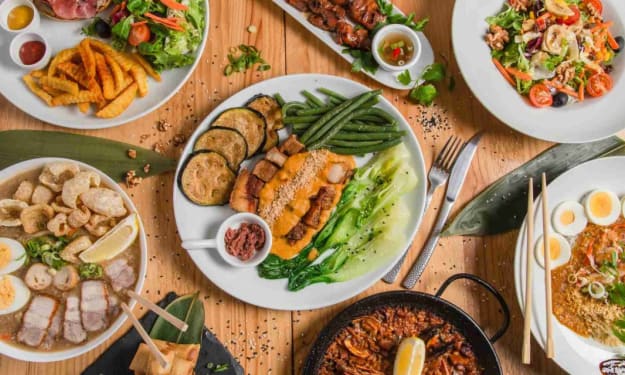5 Things We Learned About Food Culture From 'Ugly Delicious'
Chef David Chang attacks food head-on with his Netflix series that tackles subjects such as racism, cultural bias, and genuine food ignorance.

Netflix has expanded its library over the past decade with original shows, movies, and documentaries. One of these original docuseries that has struck a chord with a lot of foodies out there is the show Ugly Delicious. The show's brainchilds, chef David Chang and food writer Peter Meehan, explore various food subjects and tackle the inner workings of each. In other words, they try to find what exactly makes these food so attractive, delicious, and sometimes even problematic.
Chang, who is a self-identified "rebellious snob," follows the notion of "you can't tell me what I can and can't eat" as he ventures through foods such as pizza, tacos, steak, fried chicken, barbecue, and fried rice. On the quest to find what makes certain things so appealing, he also discovers what makes certain foods culturally harmful.

The main thing I loved about Ugly Delicious is that it's not just another food show where you watch someone eat a bunch of different foods and say how delicious they are. It looks deeper into the cultural aspects and uses each episode to really teach the viewers about the subject at hand. I definitely learned a lot watching this show which is why we are focusing on the 5 most important things we can learn from Ugly Delicious. I might have taken something different from it that someone else, but that's truly the beauty of introspection, eh?
5. "Viet-Cajun" makes a lot of sense in American Southern cuisine
If I'm being completely honest, before I watched Ugly Delicious I didn't understand why so many Vietnamese immigrants had settled in the American South. That is until I learned what attracted them to the region in the first place.

When the Vietnamese were displaced after the Vietnam War, many of them became refugees in the United States. When they got here, a majority settled in states like Texas, Louisiana, and Mississippi. The reason being is that the Mississippi Delta and the Gulf of Mexico resemble the Mekong Delta in Vietnam. It's a similar climate with similar seafood options such as shrimp and crawfish.
When it comes to the "Viet-Cajun" fusion of Vietnamese influence on classic Cajun cuisine, it actually does make a lot of sense. Just like any other influence (like how Mexico got flour tortillas), the native ways they brought to the South marry together in a sensible way. While a lot of Southern traditionalists might not agree, I think a wider and deserved acceptance is coming.
4. You're never too old to be a pit master
While the cooking world is full of young, vibrant chefs, there is a side of the industry that is a little more mature. Along with another Netflix food show, Chef's Table: BBQ, Ugly Delicious profiles a Texas pit master that is the young age of 82 (at the time of filming).

Tootsie Tomanetz is the pit master of Snow's BBQ in Lexington, Texas and proves every weekend that you're never too old to cook. She takes her childhood tradition of barbecue being a "Saturday treat" and serves her guests just one day a week - the day where she isn't a groundskeeper for the local school district. All of the hard work paid off when Snow's BBQ was named the best in Texas in 2008 by Texas Monthly.
3. Fried rice is the only authentic thing in American Chinese food
Don't be fooled by all of the sesame chicken and fortune cookies that exist in American Chinese restaurants - none of it is authentic. In the sea of Americanized food, the only menu item that stands true to Chinese cuisine is fried rice.

China actually holds a diverse food culture that varies among its provinces throughout the country. Chinese food expert Fuchsia Dunlop says that as far as food goes, China is more of a continent than a country. She also says Chinese people often regard "Western food" as monotonous and lacking texture, whereas Western culture thinks of authentic Chinese food as too exotic for them. When in the United States, you go to a Chinese restaurant and have options such as orange chicken and egg rolls. But when you go to a restaurant in China, you can eat items ranging from tendons from a deer's foot, donkey meat, or a sea cucumber.
Chang also exposes that while a lot of Chinese restaurants are full of white people, most have a "secret menu" that can be ordered in advance for those looking for more authentic dishes. This is often done so that restaurant owners don't go bankrupt offering dishes that the average American has no interest in eating. The solid tip the "fried rice" episode teaches us is that you're in the right place if you walk into a Chinese restaurant that's full of Chinese people.
2. Steak can be harvested responsibly - it just takes effort and sacrifice
Harvesting animals as we know it is on its way to becoming extinct. Well, it is if you listen to the restauranteurs and environmental experts who are saying that excessive cattle ranching is overwhelmingly contributing to climate change. But can we harvest meat without destroying the Earth?
With the rise of plant-based meat substitutes such as the Impossible Burger and Beyond Meats, it's hard to ignore that a lot of people are prepping for a meatless future. However, many ranches and farmers are trying to tackle the American notion of "more is better" by scaling back their cattle operations and ensuring they're not causing more harm to the environment than is necessary.

Ugly Delicious features a ranch in California that is taking the challenge of producing cattle for harvest with a minimal carbon footprint. The certified organic Stemple Creek Ranch prides themselves on being a carbon neutral, if not carbon positive, simply by the way they operate. By having more cattle per herd, the ranch depends on the cattle itself to aid in resting and harvesting the ground for more biodiverse soil. In other words, they're helping to fix other people's farming problems. They also don't slaughter their cattle until they're 24-28 months old, whereas the conventional industry mass breeds to execute cattle when they're 14-18 months old. Perhaps if we had more ranches like Stemple Creek, we wouldn't have to sacrifice meat as much as we might have to if things don't change.
1. Food culture can be (and often is) racist
When it comes to food, we don't always think about how what is on our plates can be contributing to racial bias. We also don't think about how the culture surrounding what's on the plate can have deeply toxic roots.
Specifically in the "fried chicken" episode, Ugly Delicious takes you on a journey where you learn that not only can food itself be racist, but also that its surrounding culture might not be as harmless as it seems. When you see a Popeye's commercial, you don't necessarily think how the portrayal of a happy, African-American woman serving fried chicken is problematic. You also might not understand that certain stereotypes that exist in American culture don't necessarily exist in other parts of the world.
Not everyone associates fried chicken with Black people, but there is an undeniable bias that does exist for some. The truth is stereotypes exist around lots of foods, specifically fried chicken. Chang shares a story where he had an African-American guest on a food show and they refused to eat the fried chicken that was prepared on camera. As a Korean-American, Chang claims he didn't understand the socio-political issues that surrounded a simple piece of food. Chang himself says,
"I didn't know about this stuff with fried chicken. You know, you're not supposed to link fried chicken, watermelon, and Black people, or African-American culture or history. You just don't talk about it... It's dawned on me that I've never actually known why Black people don't want to be associated with fried chicken."

David Simon, a creator for Treme, says on the subject of chicken and racism:
"Do you remember [Dave] Chappelle's angst when he shut down his show? You know, if you're doing that work of addressing these culturally iconic things, things that can either veer into authentic and stereotype in a moment's notice, and go from one thing to the other without you noticing it? There's that moment where he's using humor to critique racism. He's doing a character that is overtly stereotypic, trying to make a point. And he sees what may or may not be, a white guy laughing a little too hard."
Food writer Lolis Eric Elie elaborates on the subject by explaining how chicken became a stereotypical association. Chickens were the only animals that Blacks were allowed to keep during slavery, and in addition to keeping chickens, they were able to sell or cook chicken dinners for others to earn a living - often serving chicken to the people who had enslaved them. African-American Studies professor Psyche Williams-Forson supports this with pre-Civil Rights era advertisements, slogans, or logos that continued to perpetuate Black stereotypes. Just think of brands like Uncle Ben's, Aunt Jemima, and many others that have since been revamped.
About the Creator
Jenika Enoch
I love movies, music, sci-fi, and art. I'm a certified graphic designer and create my own art. Things that fuel me include equality, respect, and anything weird.






Comments
There are no comments for this story
Be the first to respond and start the conversation.